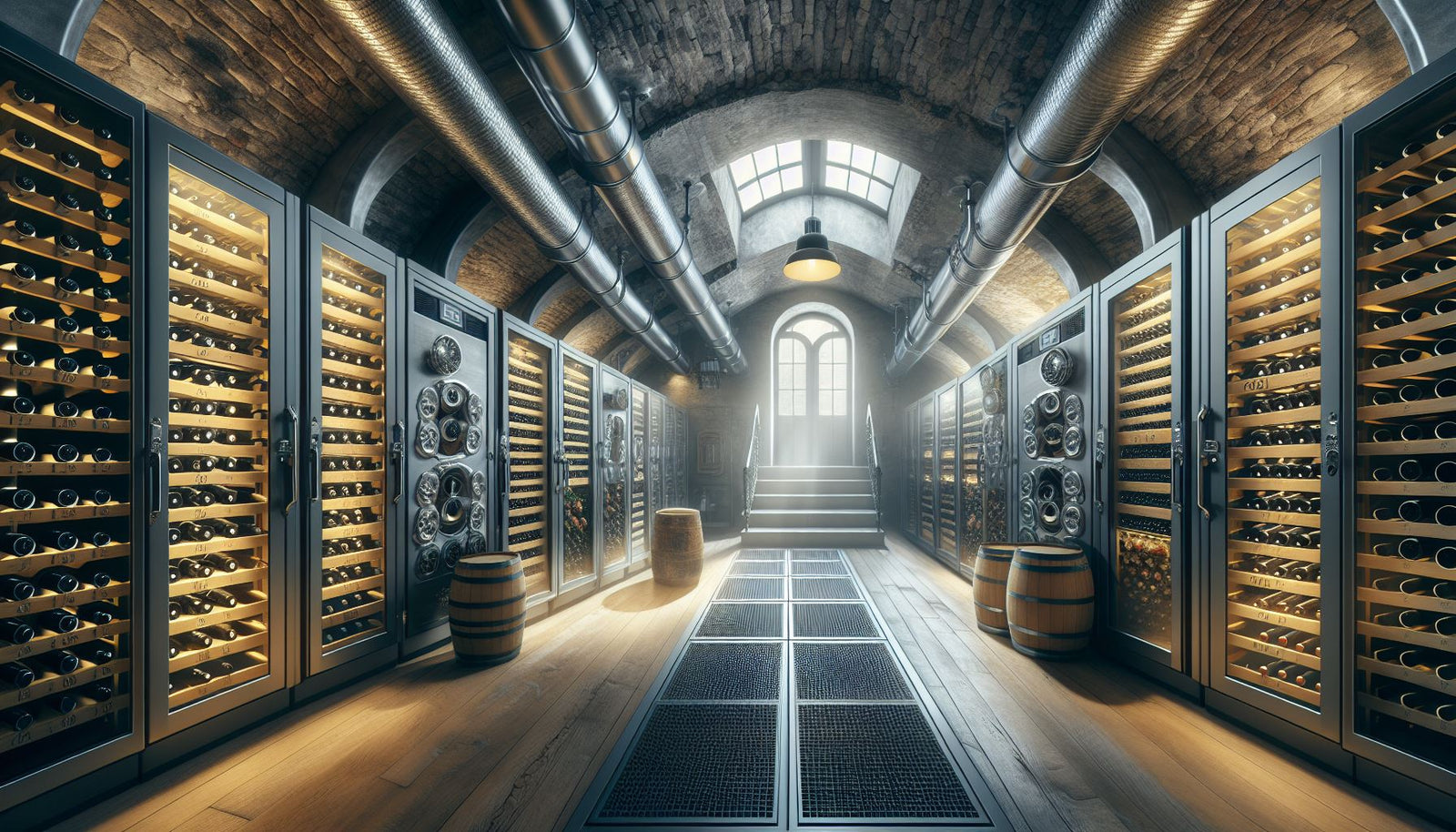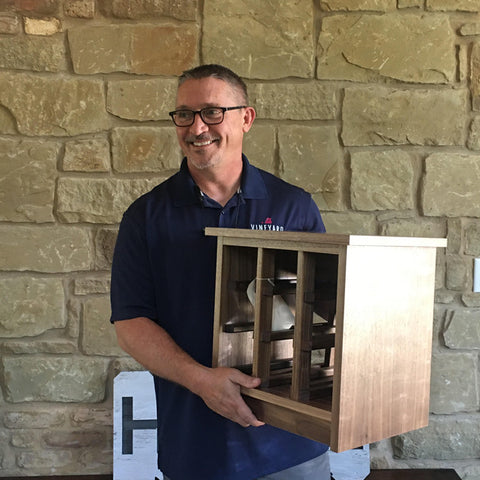So, you've got a killer wine collection and visions of a stunning wine sanctuary. The next step is creating the perfect space for your wines to mature and reach their full potential. But when building this ideal environment, which type of wine storage should you need? Active or passive wine cellars? Know the difference between the two and see which approach harmonizes perfectly with your lifestyle.
Understanding the Essentials of Wine Storage
For your treasured wine collection, long-term quality preservation hinges on four crucial factors: temperature, humidity, light, and vibration.
- Temperature: The ideal range lies between 55°F and 57°F, offering stability and preventing drastic fluctuations that can stress the wine.
- Humidity: This element is a natural humidifier, safeguarding your precious corks from drying out. Aim for a consistent 60% to 70% humidity range to prevent air ingress and potential spoilage.
- Light: Exposure to sunlight can trigger unwanted chemical reactions, subtly altering their flavor and aroma. Opt for opaque or dimly lit storage conditions.
- Vibration: Constant tremors, like those from nearby appliances or heavy foot traffic, disrupt the wine’s serenity. Minimize vibrations to ensure undisturbed maturation.
While subtle, the impact of improper storage can be devastating. Fading aromas, muted flavors, and premature aging are potential outcomes when temperature, humidity, light, or vibration fall out of balance.
What is an Active Wine Cellar?
An active wine cellar maintains ideal temperature and humidity levels through artificial means, such as a climate-controlled wine cooling system. These systems actively monitor and adjust the environment to ensure stability, which is crucial for proper wine aging.
What is a Passive Wine Cellar?
A passive wine cellar relies on natural environmental conditions (such as insulation, underground location, and thick walls) to maintain stable temperature and humidity for aging wines.
What is the difference between active and passive wine cellars?

Wine Cellar Location
- Active: Flexible placement. It can be built anywhere, regardless of natural conditions.
- Passive: Requires a naturally cool and humid location, often basements.
Climate Control
- Active: Precise temperature and humidity control through a cooling unit and humidifier.
- Passive: Relies on insulation and strategic placement to leverage natural climate, with potential for slight fluctuations.
Cost
- Active: Higher upfront cost for equipment and installation, ongoing maintenance costs.
- Passive: More cost-effective due to minimal energy consumption, but may require initial investment in insulation and design.
Maintenance
- Active: Requires regular cleaning and occasional checkups for the cooling unit.
- Passive: Requires regular monitoring of temperature and humidity to ensure optimal conditions.
Suitability
- Active: Ideal for unpredictable climates, large collections, and those seeking precise control.
- Passive: Ideal for natural conditions (basements), smaller collections, and those seeking a natural, cost-effective approach.
Active or Passive Wine Cellar: Which is Best for You
You must clearly understand your needs and budget to select a suitable cellar for your home. Here's a framework to guide your decision:
Budget
- Active: Higher upfront cost for equipment and installation. Consider if this aligns with your budget limitations.
- Passive: Generally more cost-effective, but initial insulation or space optimization investment might be required.
Collection Size
- Active: Ideal for large collections, offering consistent conditions for multiple bottles.
- Passive: May struggle with managing extensive collections effectively, potentially leading to uneven aging.
Desired Control
- Active: Provides precise control over temperature and humidity, ideal for meticulous wine enthusiasts.
- Passive: Offers less precise control, relying on natural fluctuations within a suitable range.
Available Space
- Active: Flexible placement anywhere, regardless of space limitations.
- Passive: Reliant on finding a naturally cool and humid location, often basements or underground spaces.
Scenarios favoring each approach:
- An active wine fridge might be the best choice for a small collection in an apartment with unpredictable weather.
- A passive cellar could be cost-effective if a large basement offers consistent temperatures and humidity.
Choosing a suitable cellar is a personal journey. Weigh your needs carefully, explore your options, and enjoy the process of creating the perfect haven for your treasured wines.
7 Key Steps in Building a Passive Basement Cellar

If you want to transform your basement into a wine haven, follow these simple steps:
1. Find a location.
Choose a naturally cool and humid area, preferably below ground, with minimal sun exposure. Basements in temperate regions with consistent temperatures (50-57°F) are ideal.
2. Insulate the cellar.
Seal gaps, cracks, or openings in the room to prevent outside air infiltration, maintaining a controlled environment. Insulate walls and ceiling with rigid or spray foam materials for added temperature control.
3. Ensure proper ventilation.
Install controlled ventilation to manage humidity and prevent odors. Include passive vents or a low-power exhaust fan in your passive wine cellar construction.
4. Add the shelving strategically.
Arrange bottles horizontally to keep corks moist and prevent spoilage. Position wine racks and storage units to take advantage of natural temperature variations within the basement.
5. Monitor the humidity regularly.
Install humidity monitoring devices, such as a thermometer, to keep track of moisture levels and ensure they align with optimal wine storage conditions.
6. Select the proper flooring.
Choose appropriate flooring that contributes to insulation and provides a stable foundation for wine storage.
7. Install the right wine cellar door.
Install a proper wine cellar door, ensuring a tight seal to maintain the desired climate conditions while complementing your passive wine cellar design.
Building a DIY passive wine cellar requires careful planning and ongoing monitoring. Consult professionals for advice and ensure the structural integrity of your basement before construction.
Takeaway: Active vs. Passive Cellars
Creating the perfect wine sanctuary starts with understanding the difference between active and passive wine cellars. Ultimately, the best choice depends on your needs and resources. Consider your budget, collection size, desired control level, and available space before building a home for your precious collection.
Which of the two wine cellars will suit your lifestyle and preferences?
FAQs

What are the different types of wine cellars?
There are various wine cellar types, but here are the common ones:
- Active: Uses technology (cooling units, humidifiers) to control temperature and humidity precisely.
- Passive: Relies on natural climate and insulation for stable conditions, often in basements or underground spaces.
- Wine cabinets/fridges: Compact units for smaller collections, ideal for apartments or limited space.
- Glass-Enclosed Wine Cellar: Features walls made of glass to showcase the wine collection while providing a visually striking and aesthetic appeal.
What is a bonded wine cellar?
A bonded wine cellar is a secure, government-licensed facility merchants and distributors use for storing and aging imported wines before duty and taxes are paid.
What is a dual-zone wine cellar?
A dual zone wine cellar is a unit with two separate compartments allowing storage of different wine types at optimal temperatures. Ideal for storing both red and white wines concurrently.
What is a smart wine cellar?
A smart wine cellar is an active cellar with technology like Wi-Fi connectivity and smartphone apps for remote monitoring and management.
What is an infinity wine cellar?
An infinity wine cellar is a design concept showcasing wine bottles in a visually striking, seemingly endless display, often achieved through glass walls or innovative shelving. Read Infinite Wine Cellar and How to Build Your Own.
What is the best environment for a wine cellar?
- The ideal temperature for a wine cellar is 55-57°F, offering stability and preventing fluctuations that can stress wines.
- Stable humidity (60-70%) prevents cork drying and spoilage.
- Darkness to avoid light damage.
- Minimal vibration to prevent sediment disturbance.
- Good air quality and ventilation to manage odors and moisture.
What is the best material for a wine cellar?
- Walls: Natural materials like stone, brick, or concrete offer good insulation and moisture control. Tempered glass provides protection and elegance.
- Flooring: Breathable materials like slate, tile, cork, or wood allow moisture regulation.
- Shelving: Wood, metal, cable, or acrylic for stability, versatility, and aesthetics.
What is the temperature in a passive wine cellar?
The temperature in a passive cellar depends on its location and insulation. Ideally, it should maintain a consistent range of 50-57°F year-round.
Should a wine cellar be ventilated?
Yes, proper ventilation is essential to prevent stale air and ensure a healthy environment for wine aging.
Do wine cellars add value?
Yes, well-designed and functional wine cellars can increase the value of your home, particularly for wine enthusiasts and potential buyers.
Do wine cellars need a vapor barrier?
Yes, wine cellars should have a vapor barrier to prevent moisture infiltration, helping maintain consistent humidity levels and protect the wine.
Winery vs Wine cellar: What is the difference?
A winery is where wines are produced, while a cellar is where wines are stored and aged.
At Wine Cellar HQ, we offer a diverse selection of wine cellar essentials and expertise to guide you on your wine cellar journey. Whether you seek advanced cooling units or stylish storage solutions, we're here to help you build a wine haven that reflects your passion and protects your treasured collection. Contact us today.


